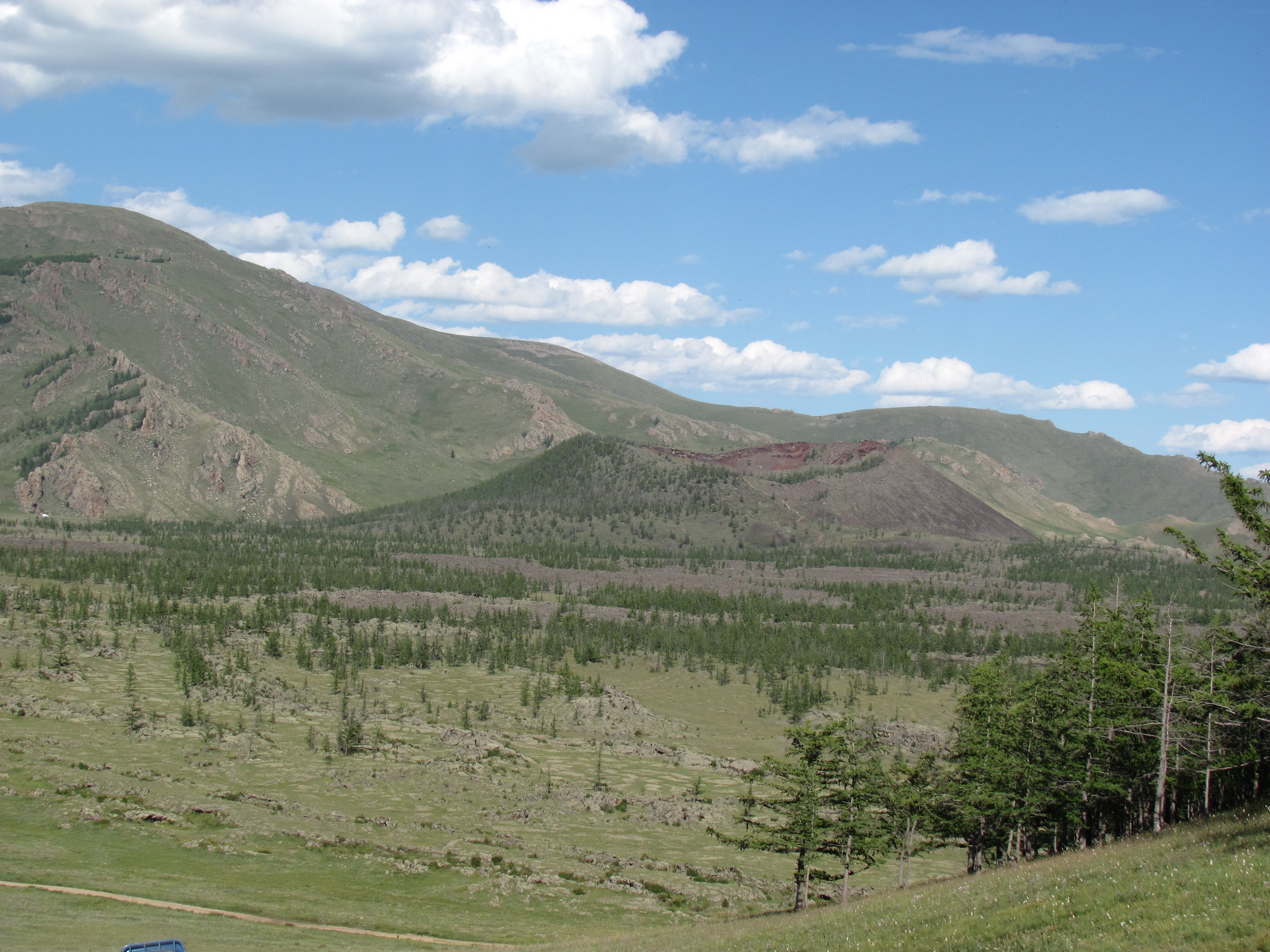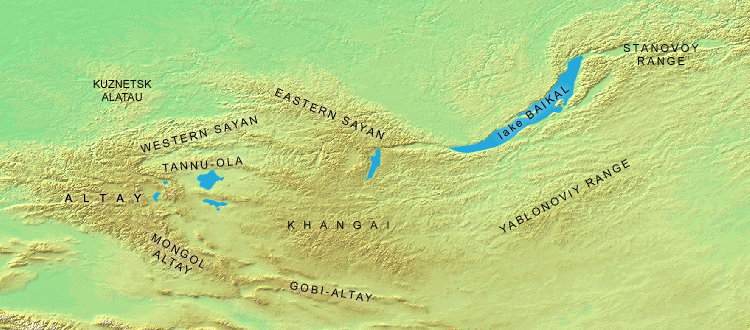Khangai Mountains on:
[Wikipedia]
[Google]
[Amazon]
The Khangai Mountains ( mn, Хангайн нуруу, Hangain nuruu, ); form a

 The tallest mountain is
The tallest mountain is Vertical Variability of Climatic Conditions in the Khangai Mountains
(1980). Brzezniak, Eligiusz; Niedzwiedz, Tadeusz. p.34.
range
Range may refer to:
Geography
* Range (geographic), a chain of hills or mountains; a somewhat linear, complex mountainous or hilly area (cordillera, sierra)
** Mountain range, a group of mountains bordered by lowlands
* Range, a term used to i ...
in central Mongolia
Mongolia; Mongolian script: , , ; lit. "Mongol Nation" or "State of Mongolia" () is a landlocked country in East Asia, bordered by Russia to the north and China to the south. It covers an area of , with a population of just 3.3 million, ...
, some west of Ulaanbaatar
Ulaanbaatar (; mn, Улаанбаатар, , "Red Hero"), previously anglicized as Ulan Bator, is the capital and most populous city of Mongolia. It is the coldest capital city in the world, on average. The municipality is located in north ce ...
.
Name
Two provinces of Mongolia are named after the Khangai mountains:Arkhangai
The Arkhangai Province or Arkhangai Aimag ( mn, Архангай аймаг, Arhangai aimag, ; "North Khangai") is one of the 21 aimags of Mongolia. It is located slightly west of the country's center, on the northern slopes of the Khangai Mou ...
(North Khangai) and Ovorkhangai (South Khangai). The mild climate area where the two provinces meet (in eastern Khangai) is known as the cradle of Mongolian and nomadic civilization. The plains at the foot of the eastern Khangai host the Orkhon Valley World Heritage Site. The Xiongnu
The Xiongnu (, ) were a tribal confederation of nomadic peoples who, according to ancient Chinese sources, inhabited the eastern Eurasian Steppe from the 3rd century BC to the late 1st century AD. Modu Chanyu, the supreme leader after 20 ...
capital Luut Khot (Lungcheng), the Xianbei
The Xianbei (; ) were a Proto-Mongolic ancient nomadic people that once resided in the eastern Eurasian steppes in what is today Mongolia, Inner Mongolia, and Northeastern China. They originated from the Donghu people who splintered into the ...
capital Ordo and the Rouran
The Rouran Khaganate, also Juan-Juan Khaganate (), was a tribal confederation and later state founded by a people of Proto-Mongolic Donghu origin.*Pulleyblank, Edwin G. (2000)"Ji 姬 and Jiang 姜: The Role of Exogamic Clans in the Organizati ...
capital Moomt (Mume) are said to have been located there. Later empires also established their capitals there: e.g. the Uyghur Khaganate
The Uyghur Khaganate (also Uyghur Empire or Uighur Khaganate, self defined as Toquz-Oghuz country; otk, 𐱃𐰆𐰴𐰕:𐰆𐰍𐰕:𐰉𐰆𐰑𐰣, Toquz Oγuz budun, Tang-era names, with modern Hanyu Pinyin: or ) was a Turkic empire that e ...
(745–840) built their capital Ordu-Baliq
Ordu-Baliqalso spelled ''Ordu Balykh, Ordu Balik, Ordu-Balïq, Ordu Balig, Ordu Baligh'' (meaning "city of the court", "city of the army"; mn, Хар Балгас, ), also known as Mubalik and Karabalghasun, was the capital of the first Uyghur ...
in the region.
Features

 The tallest mountain is
The tallest mountain is Otgontenger
Otgontenger ( mn, Отгонтэнгэр, , "youngest sky") is the highest peak in the Khangai Mountains in Mongolia. Its summit is currently calculated to reach an elevation of 4,008 meters above mean sea level (some earlier topographic maps re ...
( "Youngest sky"), which is about 4,000 metres tall. It is revered by the Mongols
The Mongols ( mn, Монголчууд, , , ; ; russian: Монголы) are an East Asian ethnic group native to Mongolia, Inner Mongolia in China and the Buryatia Republic of the Russian Federation. The Mongols are the principal membe ...
and state ceremonies are held there.
Suvraga Khairkhan, 3,117 metres tall, is another sacred mountain to the east of Tsetserleg Tsetserleg ( mn, Цэцэрлэг, ''garden'') may signify:
* Tsetserleg (city), the capital of Arkhangai aimag in Mongolia
* two sums (districts) in different aimags of Mongolia:
** Tsetserleg, Arkhangai
** Tsetserleg, Khövsgöl
Tsetserleg ( mn, ...
.
Taryatu-Chulutu
Taryatu-Chulutu ( mn, Тариатын чулуут, ''tariatyn chuluut'', "rocks of Tariat") is a volcanic field in Mongolia. It is part of a volcanic area in Central Asia in the Hangai range that may be linked to the rifting of the Lake Baikal ...
is an extinct volcanic field on the northern slopes of the Khangai Mountains.
The mountains feed the rivers Orkhon, Selenge, Ider, Zavkhan and the lakes Orog and Böön tsagaan. In the west, the Khangai mountains transition into the Great Lakes Depression
The Great Lakes Depression ( mn, Их нууруудын хотгор, ''Ikh Nuuruudyn Khotgor''), also called the Great Lakes' Hollow, is a large semi-arid depression in Mongolia that covers parts of the Uvs, Khovd, Bayan-Ölgii, Zavkhan and ...
.
The Khangai mountain region is known for its mild microclimates in certain areas. Winters there are not as harsh as in other parts of the country.(1980). Brzezniak, Eligiusz; Niedzwiedz, Tadeusz. p.34.

References
{{Authority control Mountain ranges of Mongolia